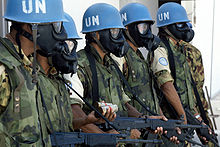
Back عملية الأمم المتحدة الثانية في الصومال Arabic UNOSOM II Catalan United Nations Operation in Somalia II German Segunda Operación de las Naciones Unidas en Somalia Spanish Opération des Nations unies en Somalie II French Operasi Perserikatan Bangsa-Bangsa di Somalia II ID UNOSOM II Italian 第二次国際連合ソマリア活動 Japanese გაერთიანებული ერების ოპერაცია სომალიში II Georgian Operasi Pertubuhan Bangsa-Bangsa Bersatu di Somalia II Malay
| United Nations Operation in Somalia II | |||||||
|---|---|---|---|---|---|---|---|
| Part of the Somali Civil War | |||||||
 Nepalese UNOSOM II troops | |||||||
| |||||||
| Belligerents | |||||||
|
| ||||||
| Commanders and leaders | |||||||
|
|
| ||||||
| Strength | |||||||
| 30,000 personnel, including 22,000 troops and 8,000 logistic and civilian staff | Unknown | ||||||
| Casualties and losses | |||||||
|
Approx. 385 casualties, including 134 - 154 killed |
Approx. 2,000 - 13,000 casualties (Somali insurgents and civilians) 2,000 casualties (Per. Peterson)[13] 6,000 to 10,000 casualties (Several estimates)[14][13] | ||||||
The United Nations Operation in Somalia II (UNOSOM II) was the second phase of the United Nations intervention in Somalia and took place from March 1993 until March 1995, following the outbreak of the Somali Civil War in 1991. UNOSOM II carried on from the transitory United States-controlled (UN-sanctioned) Unified Task Force (UNITAF), which had been preceded by UNOSOM I. Notably, UNOSOM II embarked on a nation-building mission, diverging from its predecessors.[15] As delineated in UNSCR 814, the operation's objectives were to aid in relief provision and economic rehabilitation, foster political reconciliation, and re-establish political and civil administrations across Somalia.[16]
UNOSOM II was a substantial multinational initiative, uniting over 22,000 troops from 27 nations. This operation marked the largest multilateral force ever assembled for peacekeeping, and at that time, it was the costliest UN operation.[16] Notably, it was the first UN mission authorized from the start to use military force proactively, beyond self-defense.[17]
Four months into its mandate in June 1993, UNOSOM II transformed into a military campaign as it found itself entangled in armed conflict with Somali factions, predominantly against the Somali National Alliance (SNA) led by Gen. Mohammed Farah Aidid. As the intervention progressed, military operations against the SNA took focus, relegating the task of political reconciliation, institution-building and humanitarian aid to a peripheral role.[18][15] Three months into the conflict, the US military would implement Operation Gothic Serpent to assist UNOSOM II against the SNA with special forces. Soon after, the infamous Battle of Mogadishu took place, signifying the end of the hunt for Aidid and military operations in Somalia.[19] The United States withdrew six months after the battle, and the remaining UN forces departed from Somalia in early 1995, concluding the operation.[20]
UNOSOM II faced heavy criticism for alleged human rights abuses, violations of international law, and the use of excessive force, attracting scrutiny from a wide range of humanitarian organizations, academics and journalists.[21][22][23][24] Furthermore, the operation was widely criticized for an overemphasis on military operations, diverging from its original humanitarian intent.[25] The humanitarian impact and number of lives saved is disputed.[26]
- ^ "Peacekeeping Contributor Profile: Australia". Archived from the original on 16 October 2017. Retrieved 14 December 2017.
- ^ "Peacekeeping Contributor Profile: Austria". Archived from the original on 22 November 2015. Retrieved 14 December 2017.
- ^ "Peacekeeping Contributor Profile: Bangladesh". Archived from the original on 8 April 2016. Retrieved 14 December 2017.
- ^ "Peacekeeping Contributor Profile: Belgium". Archived from the original on 14 April 2016. Retrieved 14 December 2017.
- ^ "Peacekeeping Contributor Profile: France". Archived from the original on 15 December 2017. Retrieved 14 December 2017.
- ^ "Peacekeeping Contributor Profile: Germany". 3 April 2014. Archived from the original on 2 May 2016. Retrieved 13 December 2017.
- ^ Scahill, Jeremy (2013). Dirty Wars : the world is a battlefield. Internet Archive. London : Serpent's Tail. pp. 121–122. ISBN 978-1-84668-850-8.
- ^ Utley, R. E. (2006). Major Powers and Peacekeeping: Perspectives, Priorities and the Challenges of Military Intervention. Ashgate Publishing, Ltd. p. 105. ISBN 978-0-7546-4033-2.
- ^ Woodhouse, Tom; Bruce, Robert; Dando, Malcolm (2016-07-27). Peacekeeping and Peacemaking: Towards Effective Intervention in Post-Cold War Conflicts. Springer. p. 173. ISBN 978-1-349-26213-7.
- ^ Ruys, Tom; Corten, Olivier; Hofer, Alexandra (2018). The Use of Force in International Law: A Case-based Approach. Oxford University Press. p. 493. ISBN 978-0-19-878435-7.
- ^ "India - Somalia Relations" (PDF). Ministry of External Affairs (India). February 2016. Archived from the original (PDF) on 29 April 2016. Retrieved 3 April 2017.
- ^ Drysdale 1994, p. 208.
- ^ a b c Peterson 2000, p. 88.
- ^ Pouligny 2006, p. 254.
- ^ a b Thakur, Ramesh (1994). "From Peacekeeping to Peace Enforcement: The UN Operation in Somalia". The Journal of Modern African Studies. 32 (3): 387–410. doi:10.1017/S0022278X00015159. ISSN 0022-278X. JSTOR 161981. S2CID 154768424.
- ^ a b Bradbury, Mark (1994). The Somali Conflict: Prospects for Peace. Oxfam. ISBN 0-85598-271-3.
- ^ Trama, Gustavo Adolfo (2016). Rules of Engagement (PDF). Buenos Aire: Joint Staff College. pp. 25–26. ISBN 978-987-29264-5-8.
- ^ Cite error: The named reference
:334was invoked but never defined (see the help page). - ^ Cite error: The named reference
:20was invoked but never defined (see the help page). - ^ Brune 1999, p. 33.
- ^ "The U.N.'s Greatest Failure?". Baltimore Sun. 1993-10-10. Retrieved 2023-05-28.
- ^ Cite error: The named reference
:28was invoked but never defined (see the help page). - ^ Cite error: The named reference
:332was invoked but never defined (see the help page). - ^ "Refworld | Human Rights Watch World Report 1994 - Somalia". Refworld. Retrieved 2023-05-28.
- ^ Cite error: The named reference
:5was invoked but never defined (see the help page). - ^ Tesón, Fernando R. (2017). Debating humanitarian intervention : should we try to save strangers?. Oxford University Press. p. 169. ISBN 978-0-19-020290-3. OCLC 1044938843.
© MMXXIII Rich X Search. We shall prevail. All rights reserved. Rich X Search